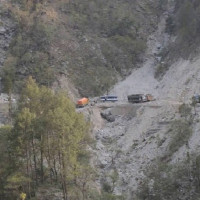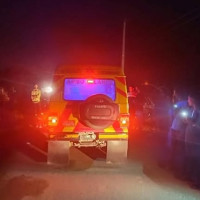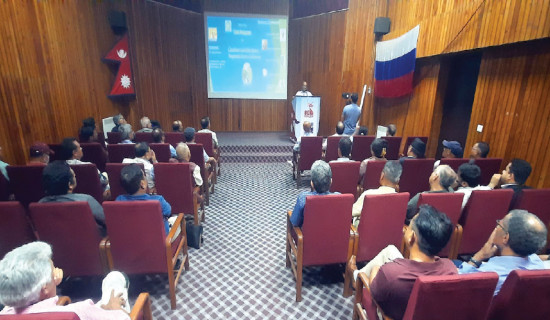- Friday, 4 July 2025
Women celebrate Teej festival across nation
By A Staff Reporter,Kathmandu, Sept. 7: Women across the country marked Teej, the most important festival of Hindu women with great fervour and devotion on Friday. All big and small temples of Lord Shiva across the nation were crowded with women of different age groups attired in red saris and kurtas.
They celebrated Teej by fasting, dancing and singing in groups.
The road towards Hanumandhoka Durbar Square from the New Road Gate and the entire Pashupati area were filled with women donned in red saris.
Teej is now no more the festival of only Brahmins and Chhetris. It has now become a common festival of other ethnic groups as well. This was evident from the growing participation of the women from Newar and other communities in the festival.
Teej celebration is now linked with the freedom and vigilance of women. Other ethnic groups are now attracted towards the festival due to the joyful environment. Haritalika Teej is known to take fasting, praying for the fulfilment of their wishes for a happy and prosperous conjugal life.
Teej song singing pattern has, of late, changed. Earlier, the songs were especially focused on expressing their past hardships and difficulties faced while being daughters-in-law. But now they focus on diverse issues.
With the modernisation of society, recorded songs have become popular in Teej, and the devotees love to dance joyfully in tune with the modern songs.
Women today put on bangles and necklaces made of glass beads, and vermillion powder which are considered the symbol of good luck. Most women dressed up in red saris, and other red outfits, love to decorate themselves with different ornaments.
As per the Hindi tradition, women observed a day-long fasting on Teej.
On Friday, a larger number of women devotees visited Pashupatinath Temple, the largest temple of Lord Shiva to offer prayers at Pashupatinath temple and other Shiva temples across the country.
All four doors of Pashupatinath were opened at 3.00 am. In the morning time, devotees entered the temple without standing more time in line due to rain. The lines became longer in the afternoon when it stopped raining, Rewati Raman Adhikari, the spokesperson for Pashupati Area Development Trust (PADT), said.
Devotees did not have to stand hours to enter the temple because less special worships, which consume more time, were organised this time.
Four separate lines of devotees were arranged to enter the main temple. The first line started from Tilganga, through Rammandir Aryaghat area and entered from the east side door. The devotees who came from Koteshwor, Tinkune and Sinamangal area, stood in this line.
The second line started from Mitra Park, third from Gausala through Pingalaesthan and Panchadewal and fourth from Guheshwori through Umakunda, Kailash. The volunteers managed the lines.
After offering worship to Lord Shiva, several groups of women or devotees on the temple premises were seen dancing and singing songs. The Pashupati area looked completely red as the devotees were in red saries and kurtas.
Similarly, the movement of devotees increased at the Chitapol of Sanga of Bhaktapur, Doleswhor, Makhendreshwor Mahadev Temple of Makhan, Gopaleshwor Mahadev Temple of Pharping and other temples.
Outside the valley, the Shiva temples - Haleshi Mahadev of Khotang district and Riseshwor Mahadev of Dolakha were also crowded with devotees
















